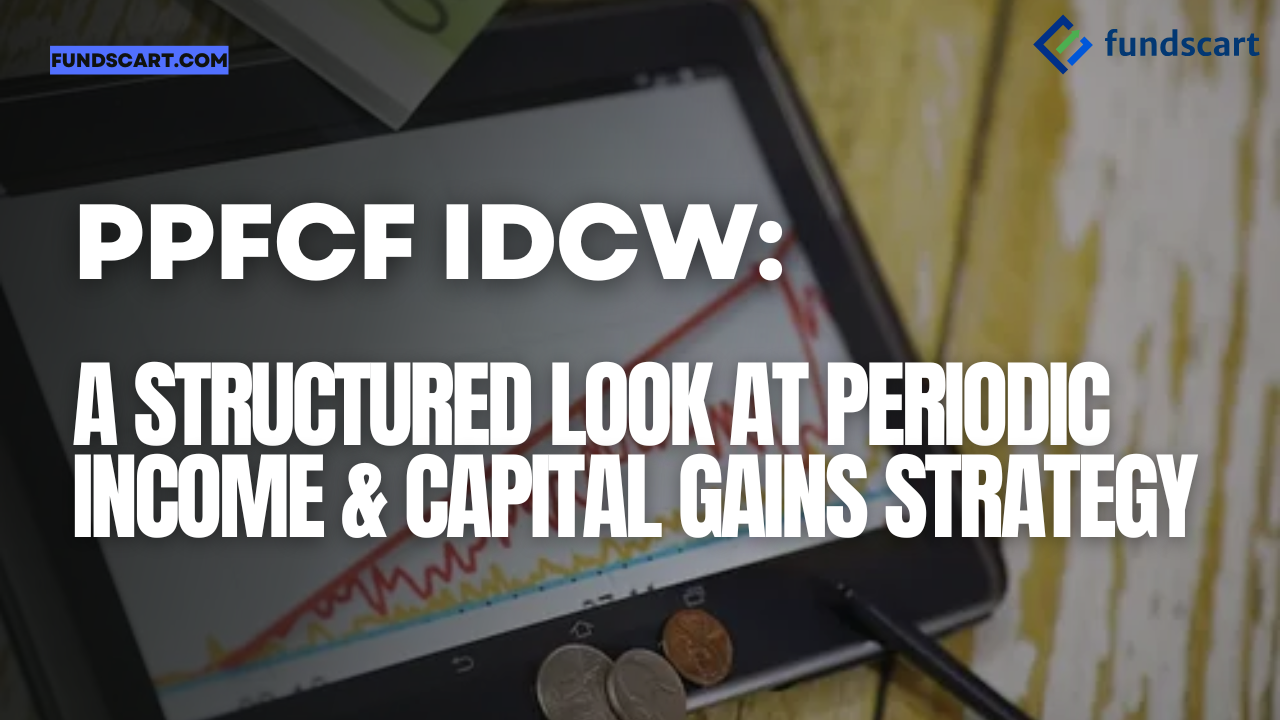
PPFCF IDCW: A Structured Look at Periodic Income & Capital Gains Strategy
Introduction: Structural Shift in PPFCF
Parag Parikh Flexi Cap Fund (PPFCF) historically offered only a Growth option. Effective October 31, 2025, the fund will introduce an Income Distribution cum Capital Withdrawal (IDCW) option alongside Growth.
This change is a fundamental attribute change under SEBI regulations. The AMC provides a special 30-day exit window (October 1–30, 2025) to redeem or switch without exit load for investors who do not consent to the new option.
Key Point: IDCW is not a guaranteed dividend. Payouts come from realized distributable surplus and are taxed as normal income. It is distinct from fixed-income schemes.
IDCW Option Mechanics
Facilities under IDCW:
Payout: Investor receives IDCW in bank account.
Re-investment (Reinvest Plan): IDCW is automatically reinvested in the scheme; it does not hit the bank account. This allows partial withdrawal of gains tax-free and reinvestment at the same NAV.
Default: If no option selected, the scheme defaults to Growth; within IDCW, Payout is default.
Operational Timelines:
Record date and quantum of IDCW set by Trustee, subject to distributable surplus.
Payment is made within 7 working days, up to 9 in exceptional cases. AMC liable for interest on delay.
For demat units, payout is linked to bank account registered with depository.
Switching Rule: Existing Growth investors cannot automatically switch to IDCW post-October 31, 2025, without redemption and reinvestment.
Taxation of IDCW
Dividend Income Tax (Post-April 1, 2023):
IDCW payouts are taxed as Income from Other Sources at the investor’s applicable slab rate.
Low-income investors with total income (including IDCW) ≤ ₹12 lakh can receive IDCW payouts tax-free under the new regime.
TDS / Reporting:
For FY 2025–26 (launch year), IDCW payout exceeding ₹10,000 triggers TDS at 10% (Form 15G/15H can prevent it if eligible).
Include IDCW in your ITR under “Other Income.”
Capital Gains Taxation (Equity-Oriented Funds)
For units held in Growth option:
| Holding Period | Tax Rate | Notes |
|---|---|---|
| ≤ 12 months (STCG) | 20% | Post-July 23, 2024, STCG on equity funds taxed at flat 20% with STT paid. |
| > 12 months (LTCG) | 12.5% | Gains exceeding ₹1.25 lakh exemption per FY. |
Note: LTCG exemption limit increased to ₹1.25 lakh (from ₹1 lakh) from FY 2024–25 (post-July 23, 2024).
Comparison with IDCW:
Growth option capital gains taxed on redemption; IDCW payouts taxed in year of distribution.
Low-income investors can reduce LTCG exposure via IDCW payouts if total income remains below ₹12 lakh.
Example (Illustrative)
Assumptions:
Yearly salary: ₹11 lakh
MF Investment: ₹10 lakh
Annual portfolio growth: ₹1 lakh
IDCW vs Growth Plan:
| Plan | Current Value After 5 Years | Capital Gains Tax | Notes |
|---|---|---|---|
| Growth (Default) | ₹16.5 lakh | ₹65,600 (12.5% LTCG) | No interim payout; capital gains taxed on redemption |
| IDCW Reinvest | ₹16.5 lakh | ₹34,000 (12.5% LTCG) | ₹50,000 withdrawn tax-free each year and reinvested; capital gains reduced |
| IDCW Payout | N/A | N/A | ₹50,000/year can be withdrawn as income without tax if total income ≤ ₹12 lakh |
Insights: IDCW Reinvest reduces total taxable gains while keeping portfolio value intact. Payout plan is suitable for liquidity without affecting principal, especially for senior citizens or low-income investors.
Suitability & Caveats
High-tax-bracket investors: IDCW payouts may increase taxable income, possibly exceeding Growth plan efficiency.
No guaranteed payouts: IDCW depends on distributable surplus and Trustee discretion.
TDS Reporting: Follow Form 15G/15H if eligible; payouts above ₹10,000 in FY 2025–26 attract TDS.
Switching / Exit: Post-special window, switching Growth → IDCW is treated as redemption + fresh subscription; CGT and exit load may apply.
Flexibility: IDCW allows control over reinvestment vs payout; Growth is simpler and less execution-risk-prone.
Best suited for: Retirees, low-income earners, or investors seeking periodic tax-efficient liquidity. Less suitable for high-income or growth-focused investors.
Conclusion
PPFCF’s IDCW option provides a strategic choice for investors aiming to optimize taxes and periodic liquidity:
Low-income investors: Can save taxes and reduce LTCG exposure.
Growth-focused/high-income investors: Growth plan remains simpler and may be more tax-efficient for long-term compounding.
Final Advice: Always verify facts in official AMC SID / addendum and consult a qualified tax advisor before deciding.
Ready to maximize your investments? Sign up with Fundscart today and take control of your financial future!